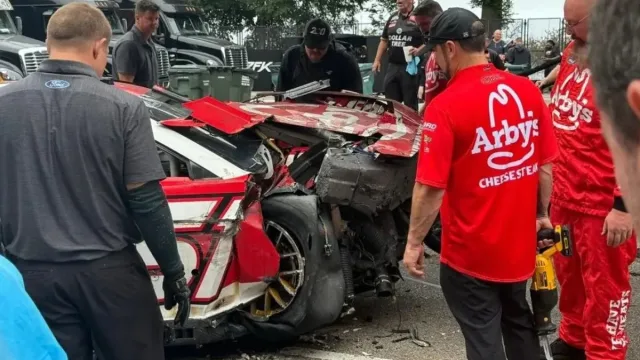Sunday’s NASCAR Cup Series race through the streets of Chicago delivered plenty of drama—but none more controversial than the hard crash involving Cody Ware. With less than two laps to go, Ware slammed into a tire barrier in a brutal wreck that left fans stunned and outraged. His immediate cry for help—“Need help”—was heard over the team radio, yet NASCAR held off on throwing the caution flag. That hesitation, which ensured the race ended without overtime, has since ignited a firestorm of criticism over NASCAR’s safety protocols and priorities.
Key Highlights
-
Cody Ware hit the tire barrier hard after a brake rotor failure late in the Chicago Street Race.
-
He radioed “Need help” immediately, but NASCAR held the caution for over 30 seconds.
-
Caution wasn’t thrown until Shane van Gisbergen took the white flag—avoiding overtime.
-
Fan videos showed the violent nature of the impact and startled officials.
-
Outrage grew online over NASCAR delaying safety response to protect the race finish.
Cody Ware’s Momentum Cut Short in Chicago
Coming off a career-highlight 13th-place finish at Atlanta, Cody Ware had reason to feel optimistic as the NASCAR Cup Series arrived in downtown Chicago. The 30-year-old driver was putting together another respectable performance before disaster struck in the closing laps.
As Ware barreled toward Turn 6, his brake rotor failed—a mechanical issue confirmed by Bob Pockrass of FOX Sports. Unable to slow, he slammed into the tire barrier with jarring force, prompting him to call out over the radio: “Need help.”
Looked like something broke huge on Cody Ware's car to cause that crash in Turn 6. Might have been a brake failure
You can see all the debris hitting Chris Buescher's car from his onboard https://t.co/eESKgv2DdV pic.twitter.com/hnaTfR0yaJ
— Steven Taranto (@STaranto92) July 6, 2025
It wasn’t just the impact that left fans and spotters stunned—it was the delay. For more than 30 seconds, NASCAR held the caution as Shane van Gisbergen neared the white flag. By the time the caution lights flashed, SVG had crossed the start/finish line, locking in the final lap and eliminating the chance for an overtime restart.
Why NASCAR’s Caution Timing Caused Uproar
In most racing series, a crash of Ware’s magnitude would trigger an immediate safety response. But this time, NASCAR waited—an action many saw as favoring the integrity of the race finish over the safety of the driver.
Had the caution come out seconds earlier, the race would’ve gone to overtime. Instead, NASCAR opted to wait until the leader took the white flag, a move that ensured the race could end under green. To fans watching live and listening to the radio feed, it felt like safety took a back seat.
“The fan video of the hit is brutal.” – NASCAR fan Reaction
WOW! What an insane angle of the last-lap crash for Cody Ware… I can’t believe that wasn’t an immediate caution.
That’s a brutal impact, look how fast he’s going into that barrier… 😳#NASCAR | 🎥: @MagnusCheeks
— Joseph Srigley (@joe_srigley) July 7, 2025
one fan said on social media.
“The NASCAR spotter and flagman about hit the deck the force was so great, yet they didn’t throw the flag.” – NASCAR fan Reaction
Another added,
“There weren’t even 40 cars on the track at that point. Their job was easier at that point and they still chose to ignore it. Shameful.” – NASCAR fan Reaction
Fans Demand Better: “Why Not Use Crash Sensors?”
Beyond frustration with the delay, many fans pointed out that other major racing leagues have already implemented automatic crash response systems. Formula 1 and IndyCar, for example, use accelerometers and telemetry to automatically trigger full-course cautions if a crash exceeds certain force thresholds.
“F1 and IndyCar have accelerometers in the cars and immediately trigger full course yellows if the impact is strong enough to cause injury. Absolutely no reason for NASCAR not to have them.” – NASCAR fan Reaction
The outrage wasn’t limited to the safety call itself—it was also about transparency. Ware’s wreck wasn’t shown in full until fan videos began circulating online, offering a clearer and more violent view of what NASCAR officials appeared to delay acting on.

A Safe Ending, But A Lingering Question
Thankfully, Cody Ware was able to walk away from the crash. But for many fans, the relief didn’t replace the deeper concern: if safety can be delayed once, what’s to stop it from happening again?
“The worst part for him was he was having a really good run,” one fan said, while another noted,
“So glad he’s okay. That fan video of the crash is insane to watch.” – NASCAR fan Reaction
In an era when NASCAR has invested heavily in safer cars, better tracks, and modern broadcast technology, this moment felt like a step back. Especially after a five-race stretch with Amazon Prime where fans praised innovation and transparency—even as they debated the move to streaming—this incident with TNT’s coverage and NASCAR’s decision-making added fuel to an already skeptical audience.

News in Brief: Cody Ware’s Violent Crash Spark Fan Outrage
Cody Ware may have escaped physical injury, but NASCAR’s reputation took a hit on the streets of Chicago. In delaying the caution flag until the white flag was taken, the sanctioning body avoided an overtime restart—but drew widespread criticism from fans, drivers, and industry insiders alike. As fans call for better technology and faster safety responses, NASCAR now faces an urgent question: how much hesitation is too much when a driver asks for help?
ALSO READ: Cody Ware’s Brutal Chicago Crash Sparks NASCAR Backlash Over Delayed Caution

